Ganymede is the largest natural satellite of Jupiter and also the largest moon in the Solar System. In fact, it is even larger than Mercury, which was once considered a planet.
Jupiter’s moon Ganymede is almost a planet in its own right. This distant world is not only the largest satellite in the Solar System, but its size also surpasses that of the planet Mercury.
Ganymede has captured the imagination of people on Earth for decades, making it a popular backdrop for many science fiction works, from Robert A. Heinlein’s novels to the animated series Cowboy Bebop. However, the facts about Ganymede may be even more fascinating than the fictional stories.
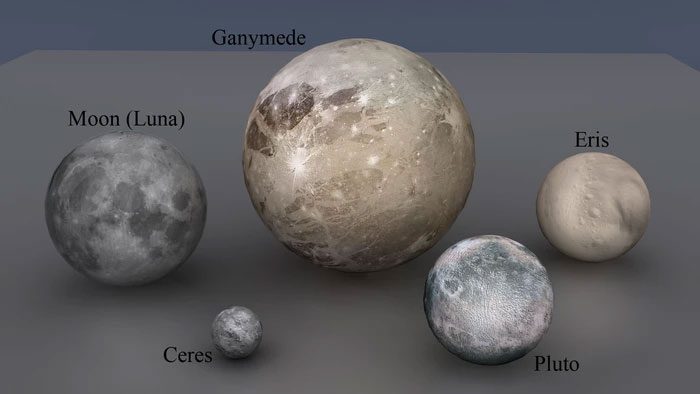
Jupiter’s moon Ganymede is almost a planet in its own right.
Ganymede was officially discovered in 1610 by the Italian astronomer Galileo. However, there is a possibility that it may have been observed much earlier. “Encyclopedia of the History of Science, Technology, and Medicine in Non-Western Cultures” mentions the ancient Chinese astronomer Gan De, who recorded observations suggesting he may have discovered this moon in 365 BC.
In his writings, he mentioned seeing a moon – “a small red star” next to Jupiter. Notably, Gan De made his observations without the use of a telescope; theoretically, Ganymede is bright enough to be seen with the naked eye, but it is often obscured by the glare of Jupiter.
In April 2023, the European Space Agency (ESA) launched a spacecraft toward Jupiter. Named the Jupiter Icy Moons Explorer (Juice), Ganymede is both a primary target and the ultimate destination in its 500 million-mile journey. Upon arrival, it will provide humanity with a closer look at this intriguing, mysterious world.
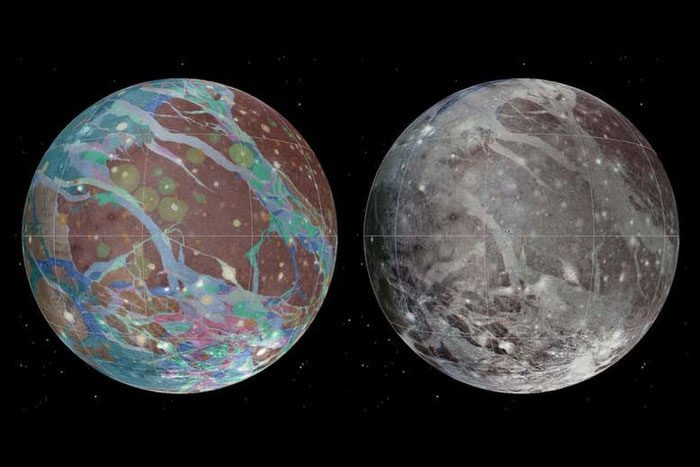
Ganymede has a diameter of 3,270 miles, about 8% larger than Mercury’s diameter of 3,032 miles.
A Moon the Size of a Planet
If Ganymede orbited the Sun instead of Jupiter, it would almost certainly be considered a true planet for several reasons. One of the main reasons is its size. It has a diameter of 3,270 miles, making it approximately 8% larger than Mercury’s diameter of 3,032 miles. The most notable planet currently considered a destination for space and robotic explorers is Mars, which has a diameter of 4,212 miles, not significantly larger compared to Ganymede.
However, the major difference between Ganymede and the planets is that it is significantly lighter than Mercury or Mars. Like Europa, another moon of Jupiter, the majority of Ganymede’s mass is made up of water and ice. As a result, its surface gravity is much lower than one would expect given its large diameter.
Thus, astronauts stepping onto Ganymede would likely feel very similar to walking on Earth’s moon.
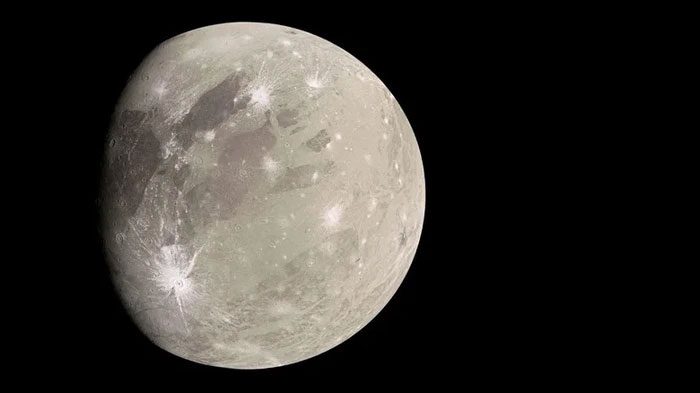
The majority of Ganymede’s mass is made up of water and ice.
A Day on Ganymede Lasts 7 Days on Earth
Ganymede rotates much more slowly than Earth. A day on this moon lasts about 7 Earth days. The reason for Ganymede’s slow rotation is that it is tidally locked with Jupiter.
Similar to Earth’s moon, Ganymede is nearly locked so that one side faces its parent planet, while the other side always turns away. In other words, a day on Ganymede coincides with its orbital period. In Ganymede’s sky, Jupiter is a fixed object that never moves from its position.
Tidal locking occurs with any moon that orbits its planet closely enough. When gravitational forces on the moon are strong enough, the closer side feels a stronger pull than the side facing away.
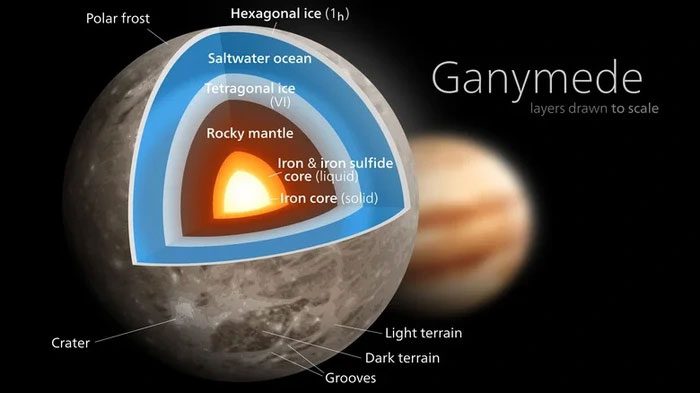
Inside, Ganymede is remarkably Earth-like.
Ganymede Has a Metallic Core
Inside, Ganymede is remarkably Earth-like. Deep beneath its surface, our planet is divided into several distinct layers of material. When the planet was still young and had not yet completed its cooling process, denser materials sank deeper into the center, which is why Earth has a core made of iron.
According to an article published in the journal Nature, this feature also exists in Ganymede. Jupiter’s largest moon is structured in a nearly similar way. If you could cut it in half, you would find several layers with distinct components.
Ganymede’s core is made of iron, similar to the cores of actual planets like Earth. Some planetary scientists suspect that Ganymede’s core may even be molten. It seems that Jupiter’s largest moon has more in common with Earth than we think.
However, the only way to be certain about this is to examine it more closely with specialized instruments. This is one of the areas that ESA’s Juice spacecraft aims to investigate further. When it reaches Ganymede, studying the moon’s core will be one of its primary scientific objectives.
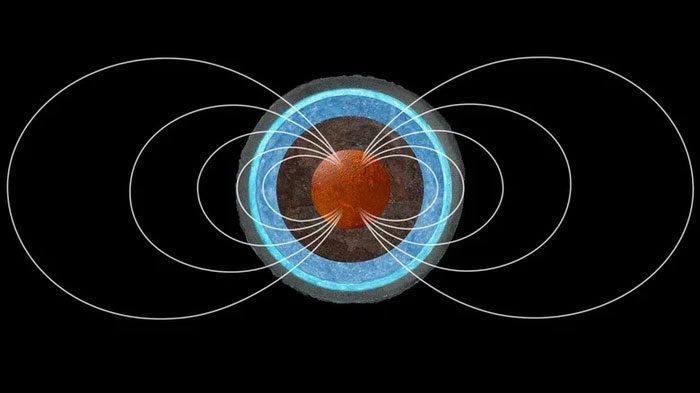
Ganymede also has a metallic core, which means it has a magnetic field.
A Magnetic Moon
The iron core of Earth is what generates our planet’s magnetic field, protecting its surface — and us — from harmful cosmic radiation. Because Ganymede also has a metallic core, it too has a magnetic field.
In fact, as NASA explains, it is the only moon in the Solar System with a planetary-like magnetic field. Ganymede’s magnetic field is likely generated by its core, but some observations suggest that something else on this moon has also affected its magnetism. Observations of Ganymede’s magnetic field suggest that it may contain a massive amount of liquid water beneath its surface, influencing the shape of this moon’s magnetic field.
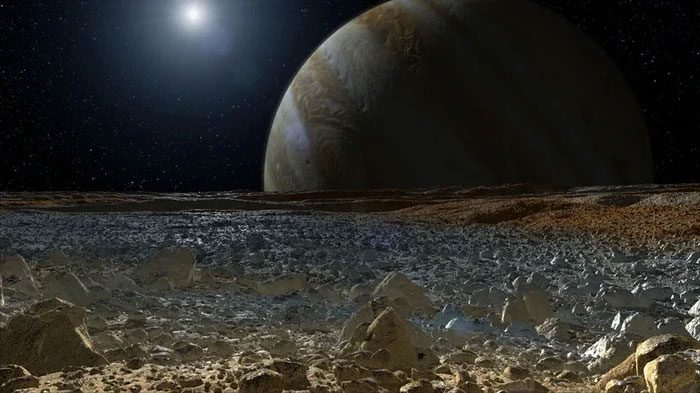
Ganymede is the only moon in the Solar System with a planetary-like magnetic field.
However, unlike Earth, Ganymede’s magnetic field is relatively weak. Even at its strongest, it is still weaker than the faint magnetic field of Mars. Meanwhile, Mars has a magnetic field that is about 40 times weaker than Earth’s.
While Earth’s magnetism shields its surface, Ganymede’s magnetic field appears too weak to perform a similar protective function. It may not offer much protection to any future astronauts who may land there.





















































